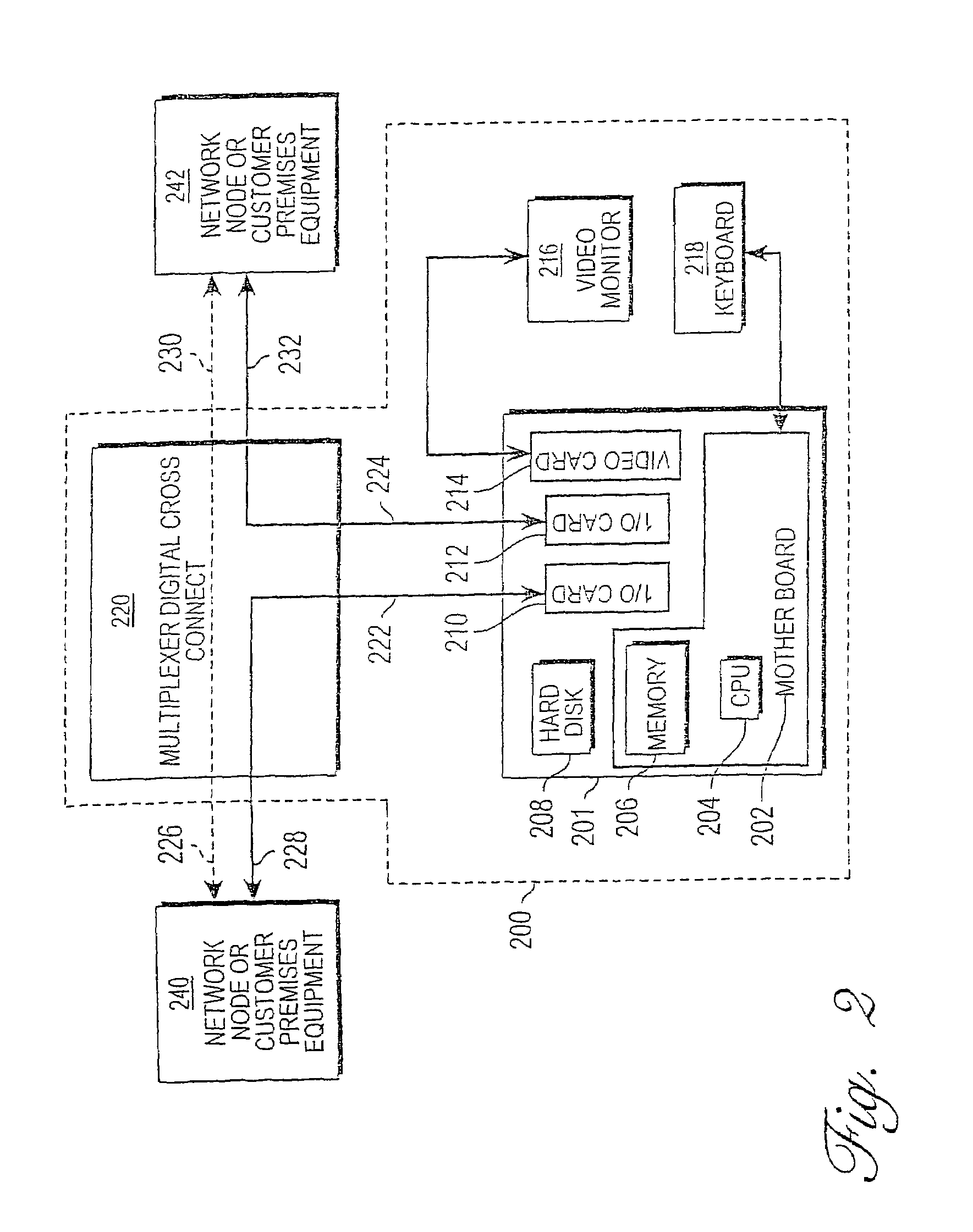[0015]Accordingly, the present invention provides an intelligent
signaling protocol converter that, for example, can be used for multiple Common Channel (e.g. C7 or PRI) and
Channel Associated Signaling (CAS) protocol conversions and that is designed to support voice to data protocol conversions in its next generation. The present invention is a true
network element that is scalable, will operate in a fault environment, and provides interfaces to
network management systems typically used in a telephone company central office environment. An
advantage of the present invention is that it can be programmed by a customer through an interface that allows the user to build, map, alter and logically convert between multiple protocols. Thus, the present invention offers programmability, flexibility and a dynamic environment not currently provided by traditional protocol conversion alternatives. It eliminates the need for the traditional
list of supported protocols commonly associated with switches and one-to-one protocol
converters by providing a
library of pre-defined protocols and it is relatively easy to add new protocols and protocol variations quickly.
[0016]The present invention provides advantages in network applications where it can be used to cost effectively expand a network and deliver central office functionality such as digit manipulation, billing and
intelligent network interfaces close to the
end user at significantly less cost than PBXs used as network switches. As such, a
protocol converter according to the present invention can be paired with any tandem switch as traffic grows and switching becomes desirable. This enables
system operators to support all current and future protocols, regardless of switch capability while freeing the switch from CPU-intensive conversion routines. This also eliminates long and costly development typically necessary to accommodate protocols and feature inter-working. As a remote access node, the
protocol converter would be transparent to the bearer channel thus enabling only one leg of compression all the way from the customer site to the
network switch.
[0017]The present invention has significant benefits for a carrier such as enabling rapid customer
interconnection of any PBX and its associated access protocol, avoiding expensive and
time consuming switch development to support new protocols, and facilitating the wider distribution of access nodes through cost effective and scalable implementations. The present invention maximizes the inter-working of supplementary features (e.g. a caller identification feature and a
call forwarding feature), improves operational efficiency through remote access to real time date, provides continuous call state analysis, and permits rapid fault isolation. The invention facilitates the
interconnection between networks, supporting network access and egress requirements, by sitting in-between the connecting switches to convert between the
core network protocols used by each network. The
software can be ported to equipment developed internally or by
third party vendors to manage protocol conversion internal to existing or future network elements. The
application software can be distributed among many platforms and storage media, or can reside on a single computer. Finally, the
software's design utilizing the universal call model facilitates the capability to map from voice protocols to data protocols to allow operators to migrate voice and data networks onto a single ATM backbone.
[0018]The present invention has significant benefits for a carrier such as enabling rapid customer
interconnection of any PBX and its associated access protocol, avoiding expensive and
time consuming switch development to support new protocols, and facilitating the wider distribution of access nodes through cost effective and scalable implementations. In addition, the present invention maximizes the inter-working of supplementary features (e.g. a caller identification feature and a
call forwarding feature), improves operational efficiency through remote access to
real time data, provides continuous call state analysis, and permits rapid fault isolation. Another
advantage of the present invention is the
elimination of decompression and recompression of the telephony signals at the access node thereby improving quality.
[0019]In one aspect of the present invention, a programmed
general purpose digital computer receives signaling messages and logically converts the signals based
on protocol definitions and customer-specified parameters into a non-protocol specific form (e.g. a generic protocol) and then converts the generic protocol into the requisite protocol of the receiving network. In this way, only one protocol converter is needed to service the expected protocols of an international telephony
system, and this same converter, because it is receiving all of the incoming traffic, is capable of being used to provide valuable
network usage data to generate network statistics and reports such as answer seizure ratio, call attempts, percentage failures and average
holding time. In one specific environment where there is a conversion from a CAS or PRI protocol to a C7 protocol, the present invention can concentrate the signaling channels with the attendant advantages of eliminating the requirements for signaling terminals and the resulting need for costly switch expansion.
[0020]One specific embodiment of the present invention is directed to a universal protocol converter that converts the protocols of a first system to the protocols of a second system and that is comprised of an interface means for connecting with the first and with the second system; and a call instance for a call in which the call instance includes a means for converting the first protocol to a non-protocol specific representation, and then from this representation to the second protocol. This one embodiment can also include a generic state means for keeping track of the call by storing only data obtained from the non-protocol specific representations. It can also include a means for storing call
context data of the generic protocol that is generated during the call, and it can include a means for manipulating the non-protocol specific representation when converting to the second protocol.
 Login to View More
Login to View More  Login to View More
Login to View More 


